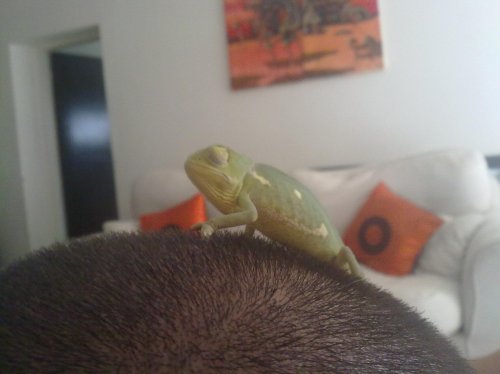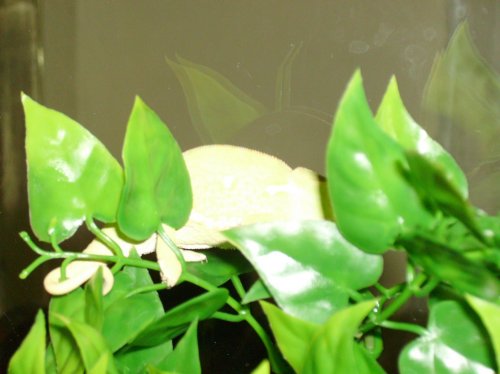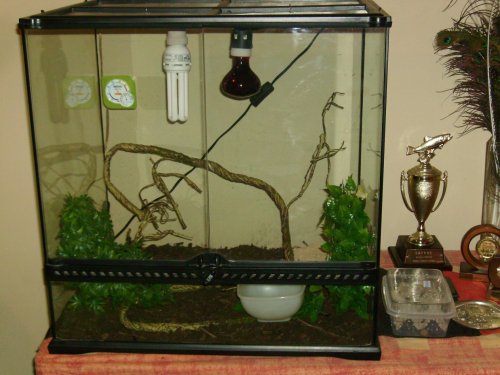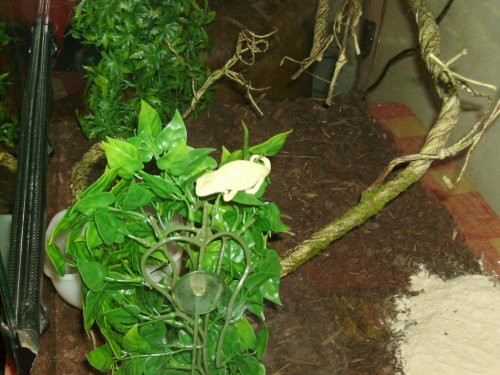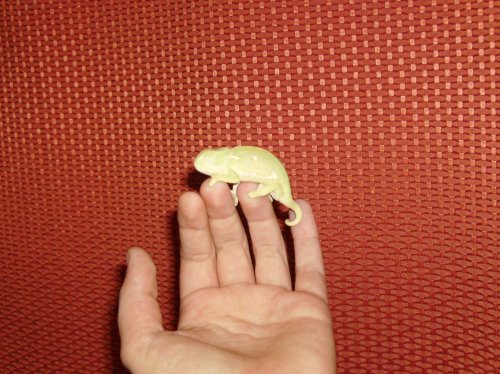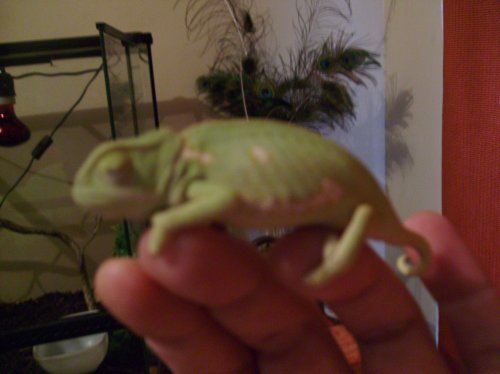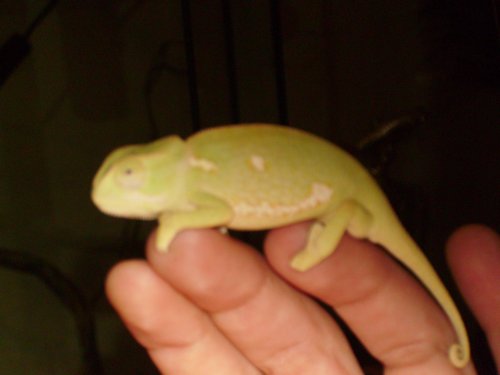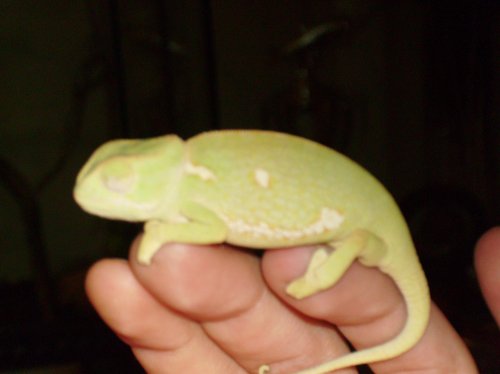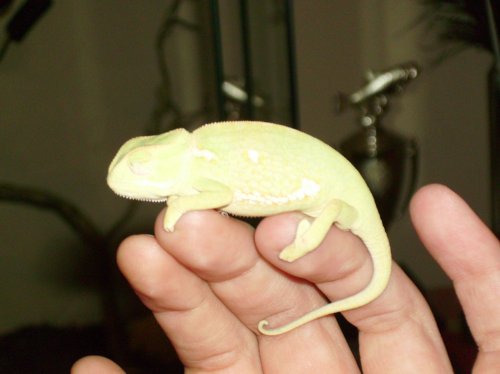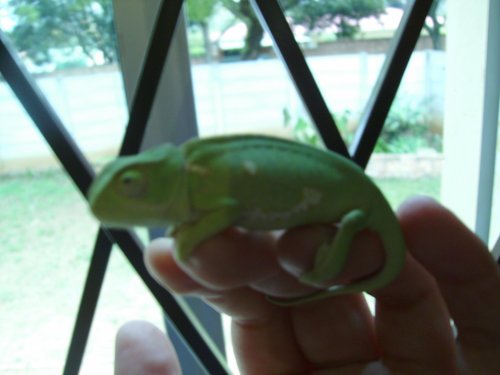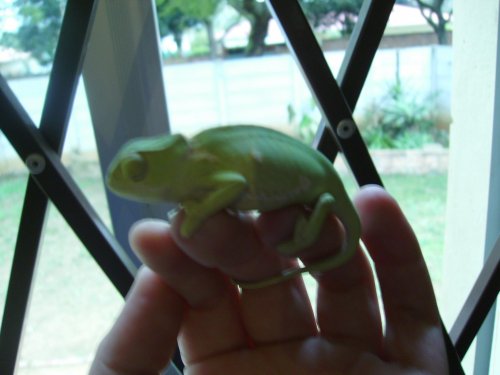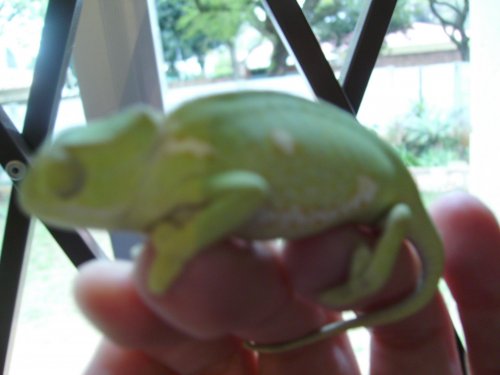Priscilla
New Member
Good day.
I hope someone can help me, my flap neck doesn't want to eat.
I did fill out that questionare so that someone can help me please!!!!!!!
It was in the wild, but my brother-in-law took it captive about three to four months ago, and he did eat there. Now I have Rango for two days, and it doesn't want to eat!!!!
Chameleon Info:
Your Chameleon:Flap neck (Will load pic to verify)
Handling:Three times a day for about 5 mins
Feeding:I feed him small crickets, about ten a day, in the afternoon, i don't know what to gut-feed him (new to this)
Supplements:I only use calcium, don't know the brand name, but i know it is peach flavour, that is what the petshop gave me.
Watering:I mist his vains, and plants. I mist about every hour, for about 1 min. I don't see him drinking.
Fecal Description:I didn't look for any dropping, so i don't know. no, it haven't been tested for parasites.
History:He did live at my brother-in-law without correct lighting a terranium. He is living with me now with coorect lighting and terranium.
Cage Info:
Cage Type:It is a combo(glass and screen). Not sure about the dimension, will take it, but it is if i should think out of my head, it is about 1 m x 1 m
Lighting:My Uvb light is a Reptisun 5.0, my infrared is a 100W, not sure about the type. I put the UVB light on about 6:30 in the morning and switch it off at 5 in the afternoon, my infrared stays on day an night.
Temperature:In the day, i try to keep it between 25 degrees celcius and 29 degrees celcius, and at night at 21 - 23 degrees celcius. I measure it with a monitot that measures temperature and humidity.
Humidity:I try to keep it between 50 and 65. I create this by misting the cage
Plants:I don't have any live plants. Don't know what type of live plants to put in, would love to put in some live plants.
Placement:It is in my living room, near my sliding door, i put it therefor the morning sun that comes in there, if i open the other windows in the home, there is a nice draft coming through, we do live in a busy street. It is about 2 metres from the floor.
Location:I live in South Africa, Pretoria
Current Problem:Rango doesn't want to eat for two days now, and i don't see i drinking.
HELP PLEASE!!!!!!!!
I hope someone can help me, my flap neck doesn't want to eat.
I did fill out that questionare so that someone can help me please!!!!!!!
It was in the wild, but my brother-in-law took it captive about three to four months ago, and he did eat there. Now I have Rango for two days, and it doesn't want to eat!!!!
Chameleon Info:
Your Chameleon:Flap neck (Will load pic to verify)
Handling:Three times a day for about 5 mins
Feeding:I feed him small crickets, about ten a day, in the afternoon, i don't know what to gut-feed him (new to this)
Supplements:I only use calcium, don't know the brand name, but i know it is peach flavour, that is what the petshop gave me.
Watering:I mist his vains, and plants. I mist about every hour, for about 1 min. I don't see him drinking.
Fecal Description:I didn't look for any dropping, so i don't know. no, it haven't been tested for parasites.
History:He did live at my brother-in-law without correct lighting a terranium. He is living with me now with coorect lighting and terranium.
Cage Info:
Cage Type:It is a combo(glass and screen). Not sure about the dimension, will take it, but it is if i should think out of my head, it is about 1 m x 1 m
Lighting:My Uvb light is a Reptisun 5.0, my infrared is a 100W, not sure about the type. I put the UVB light on about 6:30 in the morning and switch it off at 5 in the afternoon, my infrared stays on day an night.
Temperature:In the day, i try to keep it between 25 degrees celcius and 29 degrees celcius, and at night at 21 - 23 degrees celcius. I measure it with a monitot that measures temperature and humidity.
Humidity:I try to keep it between 50 and 65. I create this by misting the cage
Plants:I don't have any live plants. Don't know what type of live plants to put in, would love to put in some live plants.
Placement:It is in my living room, near my sliding door, i put it therefor the morning sun that comes in there, if i open the other windows in the home, there is a nice draft coming through, we do live in a busy street. It is about 2 metres from the floor.
Location:I live in South Africa, Pretoria
Current Problem:Rango doesn't want to eat for two days now, and i don't see i drinking.
HELP PLEASE!!!!!!!!
Last edited:


